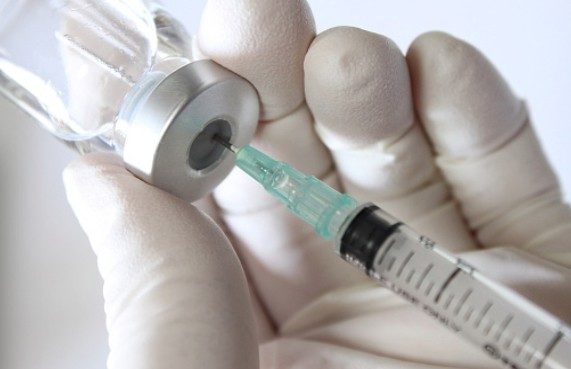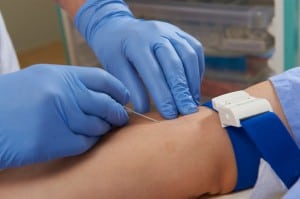Predicting failure of intravenous access in adults

Our aim was to validate prior need for an advanced technique to establish intravenous access as a predictor of failure to achieve access via traditional methods and to estimate the risk difference associated with this finding” Witting et al (2019). Abstract: BACKGROUND: When intravenous access cannot be established using traditional methods of inspection/palpation, advanced methods […]
IV flush volume required for peripheral intravenous catheters

“To test the feasibility of an efficacy trial comparing different flushing frequencies and volumes to reduce peripheral intravenous cannula (PIVC) failure in paediatric inpatients” Kleidon et al (2019).
CLABSI in pediatric hematology-oncology inpatients

This cross-sectional study was a retrospective review of CLABSI in inpatient pediatric hematology-oncology cases with long-term central venous catheter at the Pediatric Hematology Department from January 2013 to June 2014″ Özalp Gerçeker et al (2019). Abstract: Central line-associated bloodstream infections (CLABSIs) are still a major cause of morbidity and mortality in pediatric hematology-oncology patients in […]
Development of a unit-based safety program to prevent CLABSI

Interventions included the Comprehensive Unit-based Safety Program to improve safety culture and evidence-based bundles to prevent central line-associated bloodstream infection (CLABSI), surgical site infection (SSI), and ventilator-associated pneumonia (VAP)” Chang et al (2019). Abstract: Using a pre-post design, this study examined the impact of a multifaceted program to simultaneously improve 3 health care-associated infections and […]
Systematic review examines risk of bloodstream infection associated with implantable ports

This systematic review and meta-analysis aimed to provide evidence-based guidance to better understand the risk of central line-associated bloodstream infection (CLABSI) in cancer patients who received totally implantable venous access ports (TIVAPs) compared with those who received external central venous catheters (CVCs)” Jiang et al (2019). Abstract: OBJECTIVE: This systematic review and meta-analysis aimed to […]
Infection free midline catheter implementation reviewed

Adoption of a vascular access nurse led midline catheter program, coupled with device selection algorithms expanded the ability to select the right device for the patient, while decreasing excess central line usage without additional increased risks to the patient” DeVries et al (2019). Abstract: BACKGROUND: To reduce excess central line use and provide an option […]
Infection risk of small-bore tunneled central venous catheters

The purpose of this study is to evaluate the association of common clinical variables with small-bore tunneled central venous catheter (CVC) infection” Black et al 92019). Abstract: OBJECTIVE: The purpose of this study is to evaluate the association of common clinical variables with small-bore tunneled central venous catheter (CVC) infection. MATERIALS AND METHODS: Retrospective data […]
Effectiveness of synthetic polymer-coated peripherally inserted central catheter

Patients with advanced cancers who had indwelling PICCs were reviewed using their medical records. Three types of PICCs were compared in terms of complications and catheter failure” Takezawa et al (2019). Abstract: BACKGROUND/AIM: A peripherally inserted central catheter (PICC) is recommended for the safe administration of anticancer agents. The effectiveness of synthetic polymer-coated and non-coated […]
Article describes controlled infusion of intravenous cardiac drugs

The objective of the study is to develop an automatic drug infusion control system during cardiovascular surgery” Sowparnika et al (2019). Abstract: OBJECTIVES: The objective of the study is to develop an automatic drug infusion control system during cardiovascular surgery. MATERIALS AND METHODS: Based on the clinical drug dosage analysis, the modeling of cardiovascular system […]
Scoping review examines practices related with tourniquet use during peripheral venipuncture

This scoping review aims to map the available evidence on health professionals’ practices related with tourniquet use during peripheral venipuncture and associated microbiological contamination” Salgueiro-Oliveira et al (2019). Abstract: OBJECTIVES: During peripheral venipuncture, health professionals are recommended to use a tourniquet above the puncture site in order to potentiate venous distension. Given its characteristics and […]
Prevention of infusion phlebitis with topical heparin versus diclofenac

The association of superficial thrombophlebitis (ST) with deep-venous thrombosis varies between 6% and 44%. Thus, prevention of ST is important. The aim of this study was to compare the efficacy of topical quick penetrating solution (QPS) of heparin 1000 IU/mL versus diclofenac QPS for prevention of postinfusion ST” khileshwar and Singh (2019). Abstract: BACKGROUND AND […]
Nitroglycerin-Citrate-Ethanol catheter lock solution eradicates Candida auris biofilm

Candida auris poses emerging risks for causing severe central line associated bloodstream infections (CLABSIs). We tested in vitro, the ability of antifungal lock solutions to rapidly eradicate C. auris biofilms” Vargas-Cruz et al (2019). Abstract: Candida auris poses emerging risks for causing severe central line associated bloodstream infections (CLABSIs). We tested in vitro, the ability […]
Psychometric testing of a checklist for procedural training of peripheral IV cannulation

This checklist can be used for teaching IV placement in healthcare students in the simulation procedural training lab” Buckley et al (2019). Abstract: BACKGROUND: Nurses, medical technologists, nuclear medicine technologists, pre-hospital providers, and medical students are a few groups of healthcare learners asked to learn intravenous (IV) cannulation in their training (J Surg Educ. 69:536-43, […]
Validity of mini-fluid challenge for predicting fluid responsiveness

However, mini-fluid challenge has never been tested in patients with end-stage liver disease. This study investigated whether infusion of 150 ml albumin 5% can predict fluid responsiveness in cirrhotic patients following liver transplant” Mukhtar et al (2019). Abstract: BACKGROUND: Mini-fluid challenge is a well tested and effective tool to predict fluid responsiveness under various clinical conditions. […]
Oral versus intravenous antibiotics for bone and joint infection

The OVIVA (oral versus intravenous antibiotics for bone and joint infection) randomized study has challenged the practice of prolonged intravenous therapy” Seaton et al (2019). Abstract: Bone and joint infection contributes significantly to clinical activity within outpatient parenteral antimicrobial therapy (OPAT) services. The OVIVA (oral versus intravenous antibiotics for bone and joint infection) randomized study […]
Factors influencing the success of peripheral venous access in neonates

The aim of the study was to determine the optimal location and instruments to reduce the number of catheter insertion attempts and to increase time without complications” Monasor-Ortolá et al (2019). Abstract: PURPOSE: In neonatal units, the use of peripheral venous catheters is a commonly used technique involving risks and local complications. Catheter duration and […]
Central venous catheter-related deep vein thrombosis in pediatrics

In this study, we aim to identify the incidence of and risk factors for CVC-related DVT in this high-risk population, as its complications are highly morbid” Steen et al (2019). Abstract: BACKGROUND: Central venous catheter (CVC) use is common in the management of critically ill children, especially those with congenital heart disease. CVCs are known […]
Post mortem investigates chylothorax or leakage of total parenteral nutrition?

This case study focuses on a postmortem examination of an 84-year-old woman, hospitalized due to malnutrition and dysphagia. The left internal jugular vein was cannulated, with no post-procedural x-ray check-up of the catheter tip position. An autopsy revealed 800 ml of milky-white fluid in the left pleural cavity, raising the issue of whether the pleural […]
Researcher offers personal reflections on the development of propofol

The prominent position that propofol occupies as an anaesthetic and sedative agent is very gratifying. It is a personal honour that my involvement for many years in the discovery, development, and introduction of propofol has been recognised with my selection to receive the prestigious 2018 Lasker-DeBakey Clinical Medical Research Award” Glen (2019). Abstract: The prominent […]
Case of septic pulmonary embolism from catheter-related infection

We report a similar case but in a young adult who developed septic emboli due to DA that was caused by an infected peripherally inserted central catheter (PICC) line. Since the organism is highly susceptible to recurrent embolization, the PICC line was removed and the patient was treated successfully with an appropriate antibiotic regime” Patel […]
Incidence of CRBSI in patients undergoing cytoreductive surgery

The aim of this study was to calculate the incidence of catheter-related infection (CRI) in a CRS and HIPEC patient population and to assess its influence on length of hospital stay” Waters et al (2019). Abstract: Background: Cytoreductive surgery (CRS) and hyperthermic intra-peritoneal chemotherapy (HIPEC) is a complex surgical intervention with associated risks. Central venous […]
Administration of Vancomycin at high doses in patients with post neurosurgical meningitis

The aim of this study was to evaluate and compare CSF concentration and serum pharmacokinetics of high dose vancomycin by continuous infusion vs. intermittent infusion in post neurosurgical meningitis patients” Taheri et al 92018). Abstract: Poor penetration of vancomycin into Central Nervous System (CNS) can lead to treatment failure. The aim of this study was […]
Vascular access choice in children on maintenance hemodialysis

Arteriovenous fistulas (AVFs) have been recommended as the preferred vascular access for pediatric patients on maintenance hemodialysis (HD), but data comparing AVFs with other access types are scant. We studied vascular access choice, placement, complications, and outcomes in children” Borzych-Duzalka et al (2019). Abstract: RATIONALE & OBJECTIVE: Arteriovenous fistulas (AVFs) have been recommended as the […]
Systematic evaluation of pharmacometric models for vancomycin dosing

Vancomycin is a vital treatment option for patients suffering from critical infections, and therapeutic drug monitoring is recommended. Bayesian forecasting is reported to improve trough concentration monitoring for dose adjustment” Broeker et al (2019). Abstract: Objectives: Vancomycin is a vital treatment option for patients suffering from critical infections, and therapeutic drug monitoring is recommended. Bayesian […]
How to deliver central line care education at the point of care?

After a survey revealed practice gaps in central venous catheter care, one organization was challenged to identify a novel approach to educate nurses” Van Ryan et al (2019). Abstract: After a survey revealed practice gaps in central venous catheter care, one organization was challenged to identify a novel approach to educate nurses. Through a search […]
Systematic review of the effectiveness of bundles in preventing peripheral IV complications

The aim of this paper is to synthesize evidence on the effectiveness of PIVC insertion and maintenance bundles on preventing adverse events” Ray-Barruel et al (2019). Abstract: BACKGROUND: Evidence-based bundles have reduced central line bloodstream infection rates in adult intensive care units. To tackle peripheral intravenous catheter (PIVC) bloodstream infection, many hospitals have implemented PIVC […]
Bedside hand vein inspection for noninvasive central venous pressure assessment

Our purpose was to evaluate the feasibility and accuracy of CVP estimates assessed upon the height of hand veins collapse (HVC) using invasively measured CVP as the gold standard” Vogel et al (2019). Abstract: Rapid estimates of the central venous pressure (CVP) can be helpful to administer early fluid therapy or to manage cardiac preload […]
Use of continuous infusion ceftolozane–tazobactam with therapeutic drug monitoring

The safe and effective use of ceftolozane–tazobactam delivered via continuous infusion in a cystic fibrosis (CF) patient with reduced body weight and presumed augmented renal clearance is reported” Davis et al 92019). Abstract: Purpose: The safe and effective use of ceftolozane–tazobactam delivered via continuous infusion in a cystic fibrosis (CF) patient with reduced body weight […]
Reassessing standards of vascular access device care following audit

This article reports on the findings of a repeat audit of vascular access devices (VADs) in a district general hospital undertaken 4 years after a previous audit” McGuire et al 92019). Abstract: This article reports on the findings of a repeat audit of vascular access devices (VADs) in a district general hospital undertaken 4 years […]
Investigating the effect of local warming on vein diameter

This prospective non-randomised trial aimed to determine the effect of local warming on vein diameter in the antecubital area in adults aged 20–40 years” Homayouni et al 92019). Abstract: Background: Peripheral intravenous cannulation is the most prevalent invasive procedure performed on patients admitted to hospital. The procedure is not always easy to undertake and can […]

